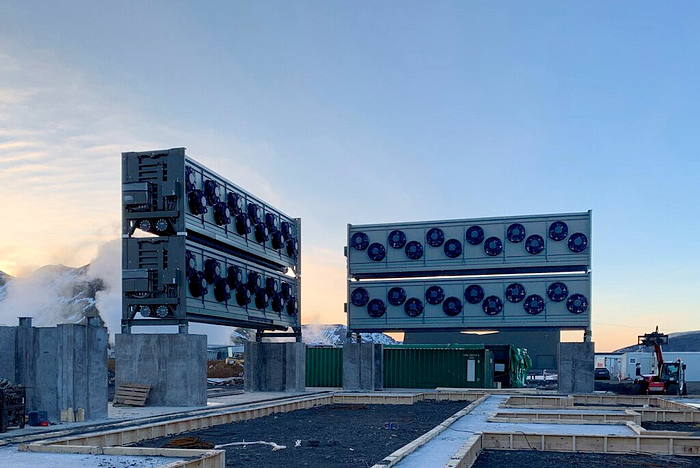Understanding DAC’s Pathways to Profitability

Imagine that the world is a bathtub, and it’s overflowing with water (CO2). There are two ways to stop it from overflowing, either you turn off the tap (stop emitting) or pull the plug (capture the carbon).
Put simply, we are never going to completely turn off that tap for a couple of reasons:
- Many key industrial processes (ex. production of cement, steel, ammonia, etc.) are nearly impossible to decarbonize.
- Impoverished countries will likely use fossil fuels to power their economies as developed countries did. It doesn’t make sense for them to face the consequences that the West brought on the rest of the world if they’re largely not responsible for it.
This leaves us to pull the plug as a last resort to drain out all of the water. However, while we are pulling the plug to stop the overflowing, we also let our money go down the drain with it.
Carbon capture’s path to profitability
“Pulling the plug,” largely falls into direct air capture (DAC) as it’s capturing carbon that’s already emitted; whereas point-source capture is “turning off the tap,” by stopping carbon from being emitted in the first place.
The current challenge with DAC is that capturing atmospheric carbon is a difficult technical problem for two reasons:
- CO2 is a very stable molecule, making it energy-intensive to break down
- CO2 isn’t highly concentrated in the atmosphere, so we need to treat enough air to fill 1.25 Empire State Buildings to capture 1 tonne of carbon.
Because of the high energy requirement to capture CO2, to hit the IEA’s target of 10 billion tons of CO2 captured yearly you would need to spend $1.4 trillion yearly just on carbon capture (at $150/ton).
For DAC to be sustainable, it needs to make a profit (even if it’s by a small margin)
There are two paths to increasing profit: Decreasing costs and increasing revenue. Decreasing costs is a long and never-ending topic which I’ll save for another article.
Increasing revenue, on the other hand, is of interest for this piece. There are primarily two revenue streams for carbon capture: carbon credits & carbon conversion (also called valorization).
Long-term, carbon valourization likely won’t be the solution to capture 10 billion tons of CO2.
For those who have been following my project work/research, that statement might surprise you. A recent conversation with Phil de Luna from Deep Sky changed my perspective on this topic entirely.
The first issue with carbon valorization is that there are a limited amount of realistic products that you can turn CO2 into, and once you do, the margins of those products can be poor.
For example, many companies turn CO2 into synthetic fuels but not only is it more expensive than the status quo, but there are also just so many better options.
Of course, this isn’t a law, and there are going to be venture-backable niches that are exceptions.
One of those exceptions in my mind is Homeostasis as their niche makes sense with regard to global context.
- We need to electrify most industries. To do that we need lithium-ion batteries
- Lithium-ion batteries are composed of 30% graphite, of which the US has a major shortage.
- Partly due to a general global shortage, but also because the largest exporter of graphite in the world, China, is heavily restricting graphite exports.
Therefore, there is a strong need for local battery-grade graphite production. This chain of reasoning and problem framing is rare for most DAC companies, making Homeostasis a unique and exciting company in the space.
But even Homeostasis will face the second issue with carbon valourization. Even if you were to find a product that’s economically viable to produce and has high margins, you would run into the issue of managing supply & demand. For example, if you turn 10 million tons of CO2 into your product, you’ll likely flood the market and drive the cost of that product to the ground (as well as your revenue).
On the other hand, if you’re not able to reach that scale in the future then you’re barely making a dent in the problem. This catch-22 makes solving the existing problem of capturing CO2 so much harder to solve as you’re dealing with getting your byproducts to market as well as going to war with thermodynamics to capture CO2 efficiently.
That’s why I believe that carbon credits are the best path towards profitability.

Carbon credits are a method of accounting for carbon emissions and creating a financial incentive for companies to emit less carbon.
The core principle is that carbon credits substitute for an emission reduction that somebody else. Therefore, if a company purchases a credit, global emissions should have had a net-zero change.
The level of confidence that people have in this principle is what determines the quality of the carbon credit. In practice, the quality of the carbon credits is graded through these criteria (which are also quite subjective):
- Additional: Is the carbon offset you’re talking about supposed to happen anyway even if there was no carbon credit system? For example, if you install energy-saving lights, the cost reductions in energy are the main factor in that decision, not the possibility of selling a carbon credit.
- Not overestimated: The situation where you say that 100 tons of CO2 are reduced instead of 50 tons. This can happen due to various reasons, which are described here.
- Permanent: Is the CO2 going to be removed for 100–1000 years? This is why forestry projects are low-quality as those carbon credits literally go up in smoke.
- Not claimed by another entity: Self-explanatory, carbon credits are non-fungible (unique) and can’t be claimed by 2 or more companies.
- Not associated with significant social or environmental harms: Also self-explanatory, but a CO2 reduction project shouldn’t cause harm to the community that it’s in or otherwise to the environment.
Adhering to all of these criteria is quite tough for most projects. The level of confidence that a company would have in those credits is going to be shaky especially if some funky accounting was suspected.
That’s why DAC has a lot of potential for creating high-quality carbon credits as it’s quite cut and dry where the reductions are coming from and where they’re going.
Initially, I was skeptical about credits as I felt that they were primarily based on whether or not the government wants to play ball or if companies need to greenwash. Since I’m being candid anyway, I also wanted to make sure that I wasn’t reasoning through a false dilemma and wasn’t considering possible alternatives.
However, credits have their own merits as they create financial incentives for companies to pollute less as well as be more sustainable.
There are two types of carbon credits, each with its uses & purposes.
Compliance Carbon Credits
Compliance credits are often what people think about when they talk about carbon credits. These credits are provided by the government and act as a ticket to emit 1 ton of CO2. Every year, each company is allotted a capped amount of carbon credits which decrease yearly in alignment with emission goals.
If you want to emit more CO2 than you’re allotted, you have to trade with another company that has extra credits to sell. This dynamic creates a carbon credit market where there are financial incentives for emitters to emit less carbon, and environmentalists to stay sustainable.
Effectively, compliance credits turn CO2 into a commodity which has a volatile price based on supply and demand from the market.
As there’s a looming shortage of high-quality carbon credits, DAC companies are well-positioned to fulfill the demand and get a sustainable source of revenue.
Voluntary Carbon Credits (Offsets)
These credits are bought so that companies can offset their emissions to be net-zero or for public image.
In countries where the government hasn’t implemented a cap-and-trade market (which is most of them), voluntary offsets can be the main source of revenue for DAC.
If a company makes a promise that they’re going to be net-zero The SEC states that you can’t bullshit that claim and you actually have to do it one way or another. A clean way and relatively easy way to do that is via these carbon offsets.
The voluntary carbon market is far more risky though. There’s no guarantee that companies will buy your credits, and that they’ll buy enough consistently for a DAC model to be venture-backable as the market is still emerging. That’s why funds like Stripe Frontier are game-changing as they guarantee a market for carbon credits with advanced market commitments (AMCs).
How Deep Sky is positioning itself to be the best carbon credit producer on the market
Deep Sky is a carbon dioxide removal project developer that is technology-agnostic. This means they partner with different carbon capture technology companies to deploy projects, rather than developing their own technology.
From first principles, making several bets in carbon capture & storage makes sense as nobody knows what technology will work the best and under what conditions. All we know for certain is that there’s no silver bullet to this problem so we should focus on multiple projects regardless.
What makes them unique is that they're not focusing on carbon valorization like much of the space is currently. Their goal is to develop as many projects as possible to fill that gap in the carbon markets.
If you want to read more about Deep Sky, check out this interview with Phil De Luna, their head of climate where he goes into detail about their story and their way of thinking.
As a sidenote, they’ve partnered with several CO2 removal & storage companies in the last 6 months, one of them being Captura which is a direct ocean capture company that I wrote about a while back. The developments in this space are moving fast and are incredibly exciting!
Key takeaways
Thank you for reading this article! I hope you learned about carbon credits through reading this article as I did when I was writing it.
- To fully drain our metaphorical bathtub, we need to make DAC sustainable.
- Carbon valourization likely won’t be the way that we will do that at scale as it’s hard to bring those products to market as well as efficiently capture carbon; except for niches like Homeostasis.
- Carbon credits seem to be the best path forward. However, it’s going to be a rocky road of navigating the carbon market, new policy, and aligning economic incentives.
- Several interesting carbon credit producers are on the rise like Deep Sky who are well-positioned to take over the carbon market with high-quality carbon credits.
Hope to see you again soon with my next article. I think it might be on the thermodynamic minimum to capture CO2 but who knows at this point.
— AK
